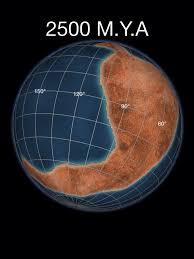
Photo from wikipedia
Abstract Several profound changes, including those involving formation of the continental crust, occurred on Earth during the Neoarchaean Era. However, the tectonic settings associated with Neoarchaean crustal growth are not… Click to show full abstract
Abstract Several profound changes, including those involving formation of the continental crust, occurred on Earth during the Neoarchaean Era. However, the tectonic settings associated with Neoarchaean crustal growth are not well understood and vigorously debated. The Neoarchaean Veligallu greenstone belt, eastern Dharwar craton hosts a variety of ultramafic, mafic and felsic volcanic rocks. Whole-rock elemental and Nd isotope data along with zircon U-Pb dating on these rocks provide significant insights into the origin and tectonic setting of Neoarchaean crust formation. The volcanism in the Veligallu belt started with ∼2.67 Ga tholeiitic basalts derived from shallow melting of a slightly depleted mantle (eNdt = +0.6 to +1.1). Moderate negative Nb anomalies, slightly elevated Th/Yb and LREE, and an absence of evidence for crustal contamination are consistent with extraction of these basalts from a mantle source weakly metasomatized by subducted slab-derived fluids in an incipient oceanic arc setting. As the arc matured, clastic sediments started forming with concurrent emplacement of komatiites, komatiitic basalts and ferropicrites showing strong signatures of contamination with continental crust (negative Nb and Ti anomalies, LREE enrichment and negative eNdt). In the final stage (∼2.58 Ga), a variety of felsic volcanic rocks (sodic trachyandesite, high Mg# andesite, rhyolite, calc-alkaline andesite) formed. The rock association and distinct geochemical signatures (enrichment of LILE, negative Nb and Ti anomalies, Mesoarchaean Nd model ages and inherited older zircons) suggest a continental margin arc environment which contained older crust. The evolutionary history of the Veligallu belt implies that both the arc- and plume-related processes, and their interplay contributed significantly to the growth of Neoarchaean crust.
Journal Title: Precambrian Research
Year Published: 2018
Link to full text (if available)
Share on Social Media: Sign Up to like & get
recommendations!